To
those whose lives they briefly touched, Los Zafiros are legends. A
musical phenomenon molded by their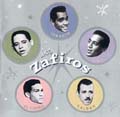 time and place, The Sapphires caused
a sensation in Havana and beyond throughout the 1960’s and into the
early ’70’s. Though they enjoyed international acclaim, touring
widely throughout Europe, Los Zafiros have remained in relative
obscurity throughout the U.S. as a result of the political climate of
the cold war.
time and place, The Sapphires caused
a sensation in Havana and beyond throughout the 1960’s and into the
early ’70’s. Though they enjoyed international acclaim, touring
widely throughout Europe, Los Zafiros have remained in relative
obscurity throughout the U.S. as a result of the political climate of
the cold war.
Inspired
by 1950’s American vocalists like The Platters, The Mills Brothers and
The Modernaires. Leoncio
‘Kike’ Morua and Miguel
‘Miguelito’ Cancio, formed Los Zafiros in Havana’s Cayo
Hueso neighborhood. During a series of auditions, Miguel and Kike found
their next member, Ignacio
Elejalde, working in a Havana hair salon. His
voice displayed a passionate counter-tenor working in the highest
registers imaginable.
The
fourth singer to join was the tall and handsome Eduardo
Elio ‘El Chino’ Hernández, whose smooth ways and
piercing delivery would make him and Kike the resident “heartthrobs”
of the group. Manuel
Galbán, already a recognized musician in Cuba, met with the
quartet in 1962 to discuss the job of musical director and guitarist.
After hearing him play his unique rock-n-roll licks and Duane Eddy-like
surf music, the boys knew 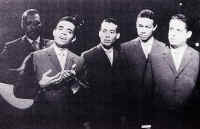 they had the fifth man on the team. Their
sensual mix of international good-time music, Rumba, R&B,
American-inspired Doo-Wop, Bolero, Calypso, Bossa Nova and the
multi-colored heritage of their native Cuba, soon brought them a rabid
female following and heavy air play on Cuban radio, making them
something like The Beatles of their day.
they had the fifth man on the team. Their
sensual mix of international good-time music, Rumba, R&B,
American-inspired Doo-Wop, Bolero, Calypso, Bossa Nova and the
multi-colored heritage of their native Cuba, soon brought them a rabid
female following and heavy air play on Cuban radio, making them
something like The Beatles of their day.
Four
decades after the group’s formation, Los Zafiros’ popularity
continues to this day, sparked by the highly successful 1998 release
“Bossa Cubana” from World Circuit Records (“Buena Vista Social
Club”). On a popular battle-of-the-bands style radio program hosted by
Adrian Mesa of 92.3 Classica-FM in Miami in December 2001, Los Zafiros
receive a majority of the call-in votes compared to their competition.
Cuban immigrants living in Miami lavish enthusiastic praise on the group
and wonder what has become of the Cayo Hueso Doo-Wop group that once
captured the world’s attention.
TREATMENT
The
only member of Los Zafiros to leave Cuba, Miguel
Cancio immigrated to Miami in 1993 in order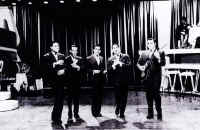 to be closer to his
children who had left Cuba thirteen years before. Though he has left his
homeland and cut back on musical pursuits, Cancio still proudly wears
the sapphire ring that gave the group its name. Purchased from a drunken
man outside CMQ studios in 1956, it has become an indelible trademark of
Los Zafiros and an important reminder of Cancio’s musical past.
to be closer to his
children who had left Cuba thirteen years before. Though he has left his
homeland and cut back on musical pursuits, Cancio still proudly wears
the sapphire ring that gave the group its name. Purchased from a drunken
man outside CMQ studios in 1956, it has become an indelible trademark of
Los Zafiros and an important reminder of Cancio’s musical past.
Ninety
miles of ocean and four decades of political tension have separated
Cancio from his homeland for nearly ten years. His return to Havana in
December 2001 to participate in this documentary and to reunite with
Manuel Galbán, the only other surviving member of Los Zafiros, filled
him with apprehension and excitement. Just as it brought them together
forty years earlier, the two men’s passion for music links Cancio and
Galbán as they visit the people and locales that played an important
role in the formation and success of Los Zafiros.
They take a trip out of Havana to the Hotel Oasis in Varadero, site of
the group’s first professional “out of town” gig in October, 1962.
While in Varadero they visit the two brothers of late Zafiros’ singer
Leoncio “Kike” Morua, where they sing, eat vast quantities of
lobster, drink and remember.
Manuel
Galbán
and his wife Magda have
been married for 35 years and still live in the same house 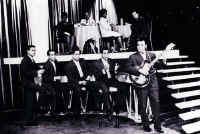 in Havana as
in the heyday of Los Zafiros. In his ten years with the group (1962-72),
Galbán had a great deal to do with creating the rich, exotic
arrangements that distinguished Los Zafiros from other Cuban popular
music of the period. Still active on the Cuban and international music
scene through his work in The Buena Vista Social Club and as a recording
artist for London’s World Circuit records, Galbán admits that his
years with Los Zafiros were the most satisfying of his long career.
in Havana as
in the heyday of Los Zafiros. In his ten years with the group (1962-72),
Galbán had a great deal to do with creating the rich, exotic
arrangements that distinguished Los Zafiros from other Cuban popular
music of the period. Still active on the Cuban and international music
scene through his work in The Buena Vista Social Club and as a recording
artist for London’s World Circuit records, Galbán admits that his
years with Los Zafiros were the most satisfying of his long career.
Cayo
Hueso’s neighborhood links to Los Zafiros have not faded over time.
The group remains as popular today as in their prime. “People on the
street” interviews in Cayo Hueso conducted by famed Cuban actress
Mirtha Ibarra feature people’s memories of the neighborhood’s most
famous native sons. Cancio and Galbán join the Havana tribute group Los
Nuevos Zafiros for an impromptu outdoor concert in Parque Trillo, a
traditional gathering place for Cayo Hueso residents.
A
crowd of locals, ranging in age from eight to eighty, gathers and sings
along. They know all the lyrics, the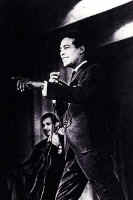 exact intonations, of the wildly
popular Zafiros’ number “Ofelia.” It is a very telling moment,
this crossing of generations through music. For Galbán and Cancio, the
sight of their old neighbors singing one of their hits is emotionally
complex and satisfying.
exact intonations, of the wildly
popular Zafiros’ number “Ofelia.” It is a very telling moment,
this crossing of generations through music. For Galbán and Cancio, the
sight of their old neighbors singing one of their hits is emotionally
complex and satisfying.
In
mid-December 2001, Nick Gold of World Circuit Records arranged a special
recording session for Galbán and Cancio at EGREM. Along with longtime
Zafiros’ collaborators Orlando “Cachaito” Lopez, Roberto Garcia
and Bernardo “Chori” Garcia, Cancio and Galbán recorded two of
their old songs. This session plays a central role in the film and marks
the first time that Galbán and Cancio have recorded together in over
thirty years.
When
the opportunity presented itself in 1965 to tour abroad with a group of
Cuban performers know as 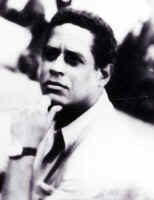 The Grand Music Hall of Cuba, Los Zafiros were
ready. They appeared in Eastern Bloc cities such as Moscow, Warsaw and
East Berlin, though it was in Paris, at the legendary Olympia Theatre,
that the five young men from Cuba really made their mark. While their
international following continued to grow, escalating political tensions
prevented them from gaining recognition in the United States. Los
Zafiros returned to Cuba at the peak of their success, though problems
had already begun to appear between the members.
The Grand Music Hall of Cuba, Los Zafiros were
ready. They appeared in Eastern Bloc cities such as Moscow, Warsaw and
East Berlin, though it was in Paris, at the legendary Olympia Theatre,
that the five young men from Cuba really made their mark. While their
international following continued to grow, escalating political tensions
prevented them from gaining recognition in the United States. Los
Zafiros returned to Cuba at the peak of their success, though problems
had already begun to appear between the members.
As
the popularity of the group increased, Galbán’s role expanded well
beyond the music. A firm hand was needed to guide the talents and
temperaments of these passionate young men. A fight between Kike and
Chino one night at the Oasis Hotel completely destroyed a hotel room.
Stories of their misbehavior became almost as much a part of their
appeal as the incredible sounds they produced. Going without food or
sleep for days at a time, Kike, Ignacio and El Chino often hit the bars
as soon their doors were opened. They were killing themselves and there
was nothing anybody could do about it.
With
hit records rolling out of Havana’s EGREM Studios, the growing
excesses of Los Zafiros’ were forgiven though not completely
forgotten. Foreign promoters, afraid of the group’s increasingly
disruptive reputation, eventually began canceling many overseas tours.
Within
Cuba, their notorious activities and the changing musical tastes caused
the quintet to drift out of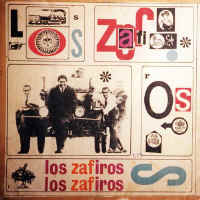 political and professional favor. Frustrated
by the unprofessional conditions and declining interest in the band
among Cuban fans and international promoters, Galbán left the group in
1972. After his departure, the remaining members tried singing with an
orchestra and made a few recordings but the results were not as before.
political and professional favor. Frustrated
by the unprofessional conditions and declining interest in the band
among Cuban fans and international promoters, Galbán left the group in
1972. After his departure, the remaining members tried singing with an
orchestra and made a few recordings but the results were not as before.
Los
Zafiros spiraled downward until officially disbanding in 1975. Ignacio
died in 1981 at the age of 37 from a brain hemorrhage. Kike died in 1983
from cirrhosis of the liver. Elio “El Chino” Hernández, beset by
severe vision, speech and drinking problems, lived alone back in Cayo
Hueso until his death on August 8, 1995 at age 56.
During
an emotional visit with Chino’s brother, violinist Jorge Hernandez
Mora, Cancio remarks that many of the old neighborhood’s residents
have passed away. “Every
time I ask Galbán about someone, he tells me, ‘He’s dead.’ I’m
afraid to ask him any more, because I’m afraid I may be next.”
Galbán and Cancio think about their three vanished friends all the
time. Kike, Chino and Ignacio bring back complex memories. Galbán
reflects,
“I
hated seeing them the way they were at the end. I think about them, the
things they said and did. They never grew up. They were always just
kids. But they had good hearts. They were born to sing. They just
didn’t know how to live.”
Ultimately,
it is the group’s music and not their demise that carries on their
legacy. In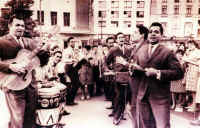 linking the disparate strands of Cuban musical and political
history, this feature-length documentary aims to present a vivid,
moving, and balanced portrait of the remarkable musical success story
that was Los Zafiros. This film also explores the emotionally complex
experience of Los Zafiros’ founder and Cuban-American Miguel Cancio
returning to his musical and family roots in Cuba. “Music from the
Edge of Time” offers up Los Zafiros’ music and their memories as
a means for uniting people long separated by political circumstances.
linking the disparate strands of Cuban musical and political
history, this feature-length documentary aims to present a vivid,
moving, and balanced portrait of the remarkable musical success story
that was Los Zafiros. This film also explores the emotionally complex
experience of Los Zafiros’ founder and Cuban-American Miguel Cancio
returning to his musical and family roots in Cuba. “Music from the
Edge of Time” offers up Los Zafiros’ music and their memories as
a means for uniting people long separated by political circumstances.
PRODUCTION
COMPLETED
During
November and December, 2001, producer/director Lorenzo DeStefano and
crew filmed over 60 hours of interviews and musical performances in
Miami and Havana. Both surviving members of Los Zafiros, Miguel Cancio
and Manuel Galbán, cooperated fully with this production. Many
prominent Cuban musicians such as Buena Vista Social Club bassist
Orlando “Cachaito” Lopez, Juana Bacallao and Oscar Aguirre were
filmed in performance and in interviews. Universally
known Cuban musical personalities Rosita Fornes, Los Papines, and
Cuban-American salsa star Manolin (“El Medico de Salsa”) also
provide their perspectives. A number of Los Zafiros family
members and friends in Havana and Miami generously shared their vibrant
memories of the group as well as their own lives during “the edge of
time,” the 1960's – the first decade of Communist rule in Cuba.
Well-known
American musicologists Tom Schnabel and Alan Geik have also contributed
interviews along with Arturo Gomez of WDNA-FM Miami and Cuban-American
musicians Luis Conte and Harry “El Chino” Kim. Filmmaker Howard
Dratch (“Roots of Rhythm” – PBS, 1990) and Nick Gold, producer of
“The Buena Vista Social Club” album, each shared their great deal of
experience in the field of Caribbean and World music.
KEY
PERSONNEL
Producer/Director
Lorenzo DeStefano
made the widely seen feature documentary "Talmage
Farlow" for The New Jersey Network/PBS. He was a
producer, director and the supervising film editor on the long-running
ABC/Warner Brothers drama series "Life
Goes On" and is author of the plays "Providence"
and "Camera
Obscura." Having worked extensively in Cuba since
the early 90's as a photographer, his photographic memoir of the island,
“La Hora
Magica / The Magic Hour – Portraits of a Vanishing Cuba,”
has been exhibited in the United States, Cuba and Canada and can be
viewed at www.lorenzodestefano.com/photography1.htm.
Executive
Producer - Randa Haines:
Director of the feature films "Children
of a Lesser God," "The Doctor" and "Wrestling
Ernest Hemingway.” A longtime friend of Cuban artists
and filmmakers, she has been instrumental from the early stages in
helping to guide this complex and ambitious production.
Executive
Producer - Sandra Levinson:
Founder and director of The Center
For Cuban Studies in New York (www.cubaupdate.org). The
Center has been promoting valuable artistic and intellectual exchange
between the United States and Cuba for over thirty years, through their
landmark outreach work with Cuban artists and filmmakers. The Center has
also introduced thousands of American visitors to the island through
their highly active cultural exchange program. Levinson’s experience
in Cuban affairs has provided this production with valuable guidance and
assistance.
Producer
& Director of Photography - Thomas Ackerman, ASC:
In addition to his feature work (“Snow
Dogs,” "Jumanji," "Beetlejuice"),
Tom has longtime documentary experience through his association with
Charles Guggenheim Productions in Washington, D.C. He photographed
DeStefano’s previous feature documentary, “Talmage Farlow,” for
PBS.
Editor
is Sergio
Palermo. Originally from Argentina and a graduate of the
film program at Pasadena's Art Center College of Design, Sergio brings a
great deal of musical and editorial experience to this project from the
many documentary and performance pieces he has crafted in his ten years
as a freelance editor.
Production
Sound by
John Austin, Pictures, Words & Music - Miami,
Florida
Associate
Producers
are
Dana Graham of The Randa Haines Company,
Victor Pina
Tabio, and the late George
Hernandez.